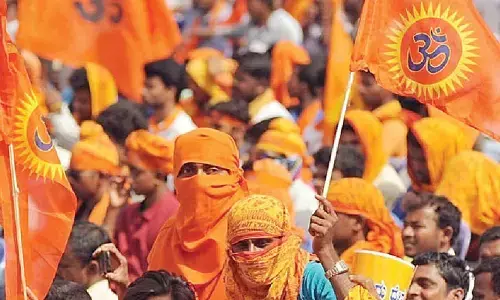India must pull itself up by the bootstraps

Representational Image
The focus of the recent meeting between United States of America and China was on Hong Kong, South China Sea, Taiwan and Xinjiang. The India-China border conflict did not figure among the issues at hand.
The focus of the recent meeting between United States of America and China was on Hong Kong, South China Sea, Taiwan and Xinjiang. The India-China border conflict did not figure among the issues at hand. This shows that the primary focus of America is on East Asia which also has interface with Japan and Australia. In other words, the bonhomie between America and India is designed to use India as a fodder for helping America attain its interests in East Asia. The United States does not intend to prod its friends in Japan, Australia and Taiwan to support India. Rather America intends to use India to support its interests in Taiwan, Hong Kong and South China Sea.
Contrary to above, it is said that India and America are natural friends since they share the values of democracy. However, we ignore that America is close to Saudi Arabia although that is not a democratic state while it is opposed to Iran which is a democratic state. Indeed, we may dispute the genuineness of democracy in Iran as also in America itself. A number of observers opine that the American democracy is a hostage to the party system. However, it cannot be disputed that Iran does have some democracy. Some of my friends in Iran were hopeful that Raisi, the candidate of the ruling party, may not get elected. This shows that Iranian democracy is not a sham.
Yet, America blatantly supports nondemocratic Saudi Arabia versus democratic Iran. Clearly, America invokes democracy selectively where it suits its interests. American foreign policy is not fundamentally driven by these cultural considerations. That said, the choice before us is between the four-country alignment of Quad consisting of Australia, Japan, India and America; or the three-country alignment RIC consisting of Russia, India and China.
Let us consider Quad first. The focus of Quad like America, as mentioned above, is on Hong Kong, South China Sea, Taiwan and Xinjiang. Quad has not been active to my knowledge in supporting India in the India China border dispute. Quad has also not been active in resisting the inroads of made by China by acquiring ports in Pakistan, Sri Lanka and Myanmar. It has failed to come up with an alternative to the Belt and Road Initiative launched by China. It is clear that the focus of the Quad is also on east Asia despite the fact that among the four members it is only India that shares a common border with China. Therefore, we should not know that Quad is using India to further its interest against China in Hong Kong, South China Sea, Taiwan and Xinjiang.
This does not mean that RIC is any better. The main difference between Quad and RIC for us is that we are getting certain frontline technologies from Quad, these will not be available from RIC. We are caught between the devil and the deep blue sea. If we hitch our bandwagon to the Quad, we may get some technologies but we will be used as fodder to promote American interests in East Asia. On the other hand, if we hitch our bandwagon to RIC then we may not be used as a fodder but we may not get the advanced technologies either. There exists no easy solution.
The only way out for India is to pull herself up by her own bootstraps. We may take a lesson here from the growth of China in 1980s and 1990s and compare those policies to hose being followed by India today. First, the domestic savings rate of China was around 45 per cent where that of India is between 20 and 25 per cent today. The high savings rate has meant that China has been able to garner the funds required for the development of advanced technologies and armaments. For example, China has built her own fighter jets and does not rely on Boeing, Sukhoi or Rafale.
China has developed temperatures equivalent to those of the sun in its laboratories. It is producing internet routers at par with CISCO systems of America. These technological advances are possible only because China has high rate of savings and has invested large amounts in these technological advances. Second, the national paradigm in China in the 1980s and 1990s was that of economic growth. The slogan then was "to be rich is glorious." I read recently that China has a policy of giving promotions to those bureaucrats who are able to increase the economic growth rate in their regions. Thus, economy takes precedence in the national dialogue.
In comparison, the dialogue in India revolves around issues like the Ram Temple, Uniform Civil Code, Article 370, 1962 war with China and the continuing conflict with Pakistan in Kashmir. In other words, the Indian mindset does not see the necessity of securing high economic growth rate and feels that India can become a powerful country even without developing a robust economy. This, in turn, leads to the devaluation of economic issues; and a corresponding focus on social and cultural issues which are important in themselves but do not lead to economic development and power. Let us not forget that Bihar under Lalu Yadav was mightily vibrant culturally for the first 10 years of his rule. I was told at that time by a businessman in Varanasi that Bihar is going to be transformed after Lalu Yadav first stint. But after 15 years, we now see that Lalu Yadav has led to economic decline of Bihar despite whatever social advances he may have made.
The fact of the matter is that the economy is the rock bed on which we have to develop our prowess. If we do not improve our economic performance, if we do not improve our domestic savings rates and if the national dialogue does not move towards economic empowerment, then we will not be successful by hitching our bandwagon either to the Quad or to the RIC.
(The author is former Professor of Economics at IIM, Bengaluru)
(The opinions expressed in this column are those of the writer. The facts and opinions expressed here do not reflect the views of The Hans India)




















